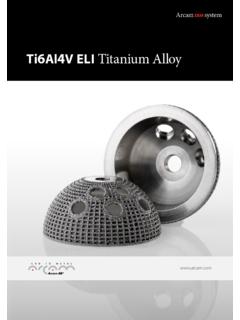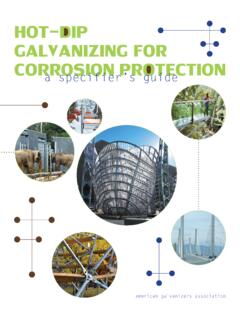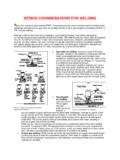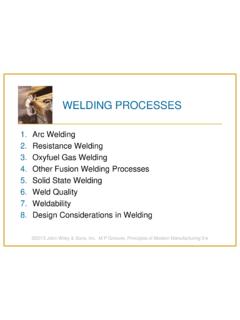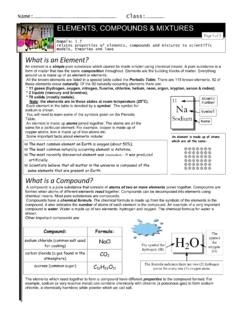Transcription of ASTM F75 ASTM F Cobalt Chrome Alloy 75 CoCr Alloy
1 ASTM F75 Cobalt Chrome AlloyArcam EBM systemArcAm EBm mAtEri Al informAtion. iSSUED noVEmBEr 2007. Arcam EBM systemASTM F75 CoCr characteristicsCobalt-based alloys have been used in demanding applications for as long as investment casting has been available as an industrial process. Arcam s Electron Beam Melting technology competes directly with investment casting and is a viable choice for manufacturing complex parts in Cobalt -based alloys. The majority of investment castings made from the Cobalt super alloys are cast in an open atmosphere. With Arcam s Electron Beam Melting process the vacuum atmosphere pro-vides a controlled environment and enables superior material properties in the manufactured alloys are widely used for medical prosthetic implant devices. The alloys are especially used where high stiffness or a highly polished and extremely wear-resistant material is required. CoCrMo alloys are the materials of choice for appli-cations such as knee implants, metal -to- metal hip joints and dental alloys also play an important role in the performance of aero- and land-based gas turbines.
2 While vacuum cast nickel alloys predominate in the hot sections of modern aero turbine engines, Cobalt alloys are routinely specified for particularly demanding applications such as fuel nozzles and vanes for indus-trial gas turbines. Arcam ASTM F75 is a non-magnetic CoCrMo Alloy exhibiting high strength, corrosion resistance, and excellent wear resistance. It is widely used for orthopaedic and dental implants. Highly polished compo-nents include femoral stems for replacement hips and knee condyles. Other Cobalt medical implants include acetabular cups and tibial trays. In all cases, but especially in hip components, material quality is imperative as parts are heavily loaded and subject to fatigue. Arcam EBM systemSpecial characteristicsThe Arcam ASTM F75 CoCr Alloy is also suitable for Rapid Manufacturing of production tools for injection moulding of plastic parts. The high hardness of the material and the excel-lent material qualities allow polishing components to optical or mirror-like finishes, and ensures long tool can be built with complex geometries, and the conformal cooling channels further enhance the tool s life and increase productivity, part and surface is typically used for: Gas turbines Orthopaedic implants Dental implants Powder specificationThe Arcam ASTM F75 CoCr Alloy powder for EBM is produced by gas atomization and the chemical composition complies with the ASTM F75 standard s specification.
3 The particle size is 45 100 microns. This limitation of the minimum particle size ensures safe handling of the powder. Please refer to the Arcam MSDS (Material Safety Data Sheet) for more information about the handling and safety of the Arcam ASTM F75 CoCr F75 CoCr AlloyPOST PROCESSINGHeat treatmentThe following heat treatment program is Hot isostatic pressing (HIP) in a shared cycle, with the following parameters: 1200 C 1000 bar argon 240 Homogenisation (HOM) heat treatment, with the following parameters: 1220 C mbar argon 240 minutes. As rapid quench rate as possible, from 1220 C to 760 C in 8 minutes maximum. The purpose is to dissolve carbides and improve the isotropy of the microstructure, reducing the brittleness of the as-built EBM manufactured in the EBM process feature good machin-ability. Parts produced using the Arcam EBM process demonstrate excellent results when using any conventional machining process. The excellent properties displayed by the parts manufactured with EBM allow polishing of the parts to a mirror or optical finish for use in dies and other applications requiring a superior surface COMPOSITION Arcam ASTM F75* ASTM F75 Requiredchromium, cr 28,5 % 27 30 %molybdenum, mo 6 % 5 7 %nickel, ni 0,25% <0,5%iron, fe 0,2% <0,75%carbon, c 0,22% <0,35%Silicone, Si 0,7% <1%manganese, mn 0,5% <1%tungsten, W 0,01% <0,2%Phosphorus, P 0,01% <0,02%Sulphur, S 0,005% <0,01%nitrogen, n 0,15% <0,25%Aluminium, Al 0,05% <0,1%titanium, ti 0,01% <0,1%Bor, B 0,006% <0,01% Cobalt , co Balance Balance* typicalMECHANICAL PROPERTIES Arcam, Arcam, after ASTM F75-07, as-built * heat treatment * requiredrockwell Hardness 47 Hrc 34 Hrc 25 35 Hrctensile Strength, 960 mPa 655 mPa Ultimate 140,000 psi 95,000 psitensile Strength, 560 mPa 450 mPaYield 80,000 psi 65.
4 000 psi Elongation at Break not applicable 20% >8%reduction of Area not applicable 20% >8%fatigue limit, rotating >10 million cycles Beam fatigue at 610 mPa (90 ksi) * typical Arcam ASTM CoCr F75 Rotating Beam Fatigue Test80070060050040030020010001,0E+0,4 CyclesLoad (MPa)1,0E+0,51,0E+0,61,0E+0,71,0E+0,8rBf S/n diagram in mPa units120,00100,0080,0060,0040,0020,000,0 01,0E+0,4 CyclesLoad (ksi)1,0E+0,51,0E+0,61,0E+0,71,0E+0,8rBf S/n diagram in ksi unitsPolished torodial bars3 x 3/8 x 3/16 4000 cpm (67 Hz)room temperature, airinterrupted at20 m cyclesHip stem at20 m cyclesPolished torodial bars3 x 3/8 x 3/16 4000 cpm (67 Hz)room temperature, airKnee microstructure, etched cross-section along the Z-direction, 50x As-built microstructure, etched cross-section along the Z-direction, 100xMicrostructure after HIP+HOM, etched cross-section along the Z-direction, 50xMicrostructure after HIP+HOM, etched cross-section along the Z-direction, 100xArcam AB | Kroksl tts Fabriker 27A, SE431 37 M lndal, Sweden | Phone: +46 31 710 32 00 | Fax: +46 31 710 32 01 | | provides Free Form Fabrication machines for Direct Manufacturing of metal parts.
5 The technology offers ultimate geometric freedom combined with first class material properties. Arcam is guided by our vision to revolutionize the art of Arcam to manufacture your CoCr parts with EBM results in fully dense parts without weld lines in the material before or after heat treatment (HIP+HOM). The as-built material consists of elongated grains containing carbide precipitation. Heat treatment transforms the micro-structure into an isotropic structure with a substantial reduction of visible images below show the typical microstructure before and after heat treatment (HIP+HOM). The as-built material has elon-gated grains in the build direction (Z). It contains a high density of carbides that result the high hardness of the as-built material. HIP+HOM completely transforms the microstructure into an isotropic state. The carbides are dissolved, leading to the in-creased ductility and reduced hardness demonstrated in the after the heat treatment specifications.
6 There is no porosity in the as built or in the HIP+HOM material.


